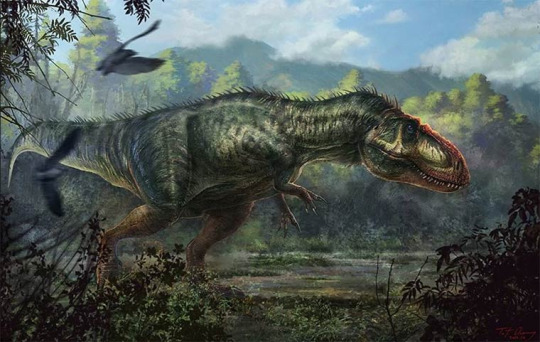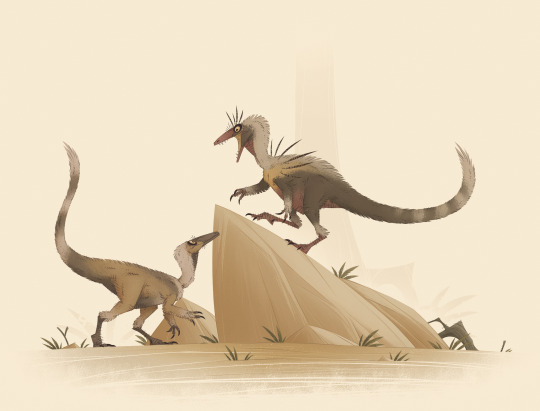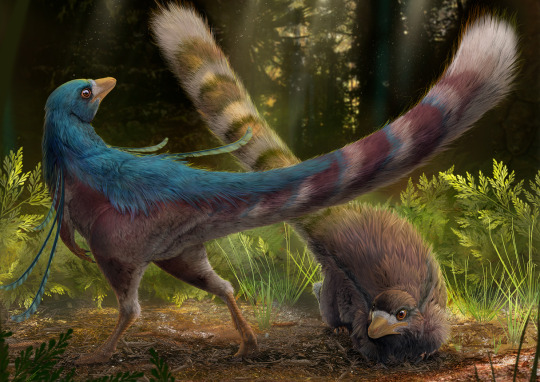#UbirajaraBelongsToBr
Text
How a Brazilian dinosaur sparked a movement to decolonize fossil science
Rather than excitement, the discovery of the species set off a Latin American movement to stop colonial palaeontology.

In December 2020, a paper in the journal Cretaceous Research sent shock waves through the palaeontology community1. It described a dinosaur species that the authors named Ubirajara jubatus — the first dinosaur found in the Southern Hemisphere to display what were probably precursors to modern feathers. The 110-million-year-old fossil had been collected in Brazil decades earlier — but no Brazilian palaeontologist had ever heard of it. The authors of the paper were from Germany, Mexico and the United Kingdom.
It was the latest instance of what some researchers now call palaeontological colonialism, in which scientists from wealthy nations obtain specimens from low- and middle-income countries without involving local researchers, and then store the fossils abroad. The practice can sometimes be illegal. For instance, according to Brazilian law, the country’s fossils belong to the state, although the authors of the Ubirajara paper say that they had a permit signed by a Brazilian mining official allowing them to export the specimen. “As far as the authors are aware, the specimen of Ubirajara was obtained legally,” says David Martill, a co-author and palaeontologist at the University of Portsmouth, UK.
The practice can also deprive nations of knowledge and heritage, say researchers. “Fossils are special to us,” says Allysson Pinheiro, director of the Plácido Cidade Nuvens Palaeontological Museum in Santana do Cariri, Brazil, near where U. jubatus was found. “We have literature, arts and crafts, and music based on them.”
Unlike previous incidents, however, the publication of Ubirajara sparked a revolution.
Through the Twitter campaign #UbirajaraBelongstoBR, Brazilian researchers protested against the paper, which was eventually withdrawn, and called for the fossil’s return. The Ubirajara specimen is currently located at the State Museum of Natural History Karlsruhe in Germany, but officials say that the museum is involved in negotiations to send it back to Brazil.
Even more significantly, the incident prompted paleontologists and paleontology associations across Latin America to join forces to end the practice. The growing movement is even attracting interest from scientists in Mongolia and other countries beyond Latin America that are affected by colonial palaeontology.
Continue reading.
#brazil#politics#science#biology#paleontology#brazilian politics#ubirajarabelongstobr#international politics#mod nise da silveira#image description in alt
629 notes
·
View notes
Text

Ubirajara jubatus, o senhor da lança.
#Ubirajara#Ubirajara jubatus#ubirajarabelongstobr#art#digital art#lineless art#dinosaur#paleoart#drawing#kyan’s art gallery
125 notes
·
View notes
Text
Thursday 21/10/21 - Dinosaurs of the World Part 6; South America

An Alverazsaurid cleaning the teeth of a Giganotosaurus, Sergey Krasovskiy
As I discussed in the opening paragraphs of previous entries of this series, the earliest dinosaur expeditions were done mostly by European or North American palaeontologists, even when in other countries. In the early 1910s, American expeditions into Mongolia brought back Velociraptor, and in the 1970s, they found the famous Fighting Dinosaurs fossil where a Velociraptor and a Protoceratops are still entwined in combat in death. In the early 1910s-1920s, German expeditions were conducted throughout various parts of Africa, bringing to light the exciting specimens of Spinosaurus, Giraffatitan and Heterodontosaurus.
But there was an issue with these expeditions, almost none of the fossils stayed in their country of discovery. Those African discoveries went to Germany, and the Fighting Dinosaurs are still displayed prominently at the American Natural History Museum. I discussed in the India/Madagascar post that Barapasaurus was the first dinosaur to have a skeletal mount in India, in 1977. What I didn't mention is that to this day, Barapasaurus is still one of the only skeletal mounts of a dinosaur in India, most are in museums outside the country.
I bring this all up because although modern discoveries are more likely to be studied and displayed in their home country, fossil smuggling and stealing is still a huge issue in today's palaeontological community. Nowhere is this more of an issue than in South America, where many dinosaur fossils make their way to European or American museums through black market trades, or by illegal exportation. South America has had some of the most interesting and extreme dinosaur discoveries, but despite strict laws in Brazil for example, where Brazilian fossils must be studied strictly in Brazil, fossils are still being stolen from native land, and displayed overseas.
I don't wanna get too preachy, but some of the dinosaurs I'm discussing today have been at the centre of some controversial and disrespectful practices, and I thought it important to give context before I get into it all. But without further ado, lets discuss some South American Dinosaurs!
Ubirajara jubatus

Ubirajara, TheDinosaurMann (twitter/furaffinity)
Ubirajara was a Compsagnathid theropod from Early Cretaceaous Brazil. Its fossil was discovered in a chalk mine in North Eastern Brazil in 1995 but was illegally exported to Germany, where its fossils were studied, described, and remain to this day. The Brazilian Palaeontological Community have campaigned for the return of the remains to Brazil, but there has been no luck so far.
Its genus name, Ubirajara (you-bee-rah-jar-ah), comes a South American native language called Tupi, and translates into "Lord of the Spear", referring to the large keratinous spines erupting from the base of its neck. Given their structure, these spines were most definitely meant for display. A variety of simple spines of various sizes run down the neck and back of Ubirajara, leading experts to think it had very advanced sexual display features, comparing the dinosaur to the modern Peacock. In life, Ubirajara was about 40cm tall at the shoulder, and 1 m long from nose to tail tip.
Patagonykus puertai

Patagonykus, Emily Stepp
Patagonykus was an Alvarezsaurid theropod from Early Cretaceous Argentina. Patagonykus translates in Greek to "Patagonian Claw", and that "claw" singular is very fitting for such a dinosaur. Alvarezsaurs like Patagonykus were a highly derived group of theropods that were seemingly adapted for an insectivorous lifestyle. Their narrow snouts were suited for pushing into tree hollows or insect nests, and some scientists think they may have had long tongues. Although not confirmed in all Alvarezsaurs, many, like the Mongolian Shuvuuia or Patagonykus itself, have evidence of a hand with a single claw. This one fingered hand was not vestigial however, and palaeontologists think that Patagonykus used this claw to dig into the ground or tree bark to uncover insects to eat. Patagonykus was one of the larger Alverezsaurids, at least 1 m long.
Amargasaurus cazaui

Amargasaurus, @alphynix (tumblr)
Amargasaurus was a Dicraeosaurid sauropod from Early Cretaceous Argentina. I described the family's namesake, Dicraeosaurus, in the episode on Africa. Like all Dicraeosaurids, it had a shorter neck for a sauropod, as well a smaller body size in general, it was 2.7 m tall at the shoulder and around 10 m long; a large animal, but small for a sauropod. Amargasaurus was named for La Amarga, a town nearby its site of discovery, and although it has no bearing on the animal itself, Amarga is Spanish for "bitter". The most unique aspect of this dinosaur's anatomy is the dual row of spines rising from the base of the neck, all the way up the Amargasaurus's head. Some paleoartists portray these spikes as supporting a skin sail, but many suspect they were bare in life, and may have served as defense against ancient Argentina's large predators.
Carnotaurus sastrei

Carnotaurus, Roberto Akeiron
Carnotaurus was a large Abelisaur theropod from Late Cretaceous Argentina. Due to the completeness of its fossils, it is one of most well-studied dinosaurs of the southern hemisphere. Its name means "meat eating bull", referring to its pair of large brow horns. I have previously written about the absurd anatomy of this dinosaur: Mouth on Legs; Carnotaurus, so I'll just briefly discuss the main points here.
Carnotaurus was a very agile and slim theropod. Its muscular legs and tail made it well adapted for sprinting, quickly chasing its prey. Its skull was short and strangely elastic, leading palaeontologists to believe it may have been able to flex its jaw like modern pythons, to swallow larger portions of food. Given its almost certainly vestigial arms, which did not even have a proper elbow, it would've hunted almost exclusively with its mouth. Modern interpretations think it would've hunted large sauropods, bring them down with multiple savage bites to the neck. Its horns were unlikely to be used in hunting, so its thought they were used in intraspecific sexual display or head butting contests. It was a really weird animal, so please read my other article if you're interested.
Eoraptor lunensis

Eoraptor, tnilab-ekneb121 (deviantart)
Eoraptor was an Early Saurischian dinosaur from Late Triassic Argentina. Its genus name means "Dawn Plunderer", referring to its grasping hands, and that it was one of the earliest true dinosaurs we have found so far. Its species name, lunensis, refers to Valle de la Luna, where it was found. Eoraptor was one of the first dinosaurs, and when it was alive, the Earth was ruled by stem-mammals, crocodile relatives and large amphibians. Given how primitive its skeletal traits are, it is uncertain whether Eoraptor was a basal Sauropod, Theropod, or maybe even before the two groups split. Its skull and claws were unspecialised for any sort of advanced predatory behaviour, but palaeontologists conclude it likely ate small lizards, fish, and insects. It would have been around 30 cm tall and 1 m long.
Austroraptor cabazai

Austroraptor, AdrianArt (Artstation)
Austroraptor was a large Dromeosaur theropod from Late Cretaceous Argentina. It was a strangely shaped dinosaur and one of the largest species of raptor dinosaur ever, about 1.5 tall at the shoulder and 6 m long from nose to tail tip. Austroraptor means "Southern Thief", as most dromeosaurs had been found in the northern hemisphere. The specific subgroup Austroraptor was from, the Unenglaniiae, had longer legs than most dromeosaurs, implicating a capacity for long distance pursuit rather sprinting like in Velociraptor. Austroraptor also a longer snout, possibly hinting at a fish-eating diet.
Oxalaia quilimbensis

Oxalaia, Alexander Vieira
Oxalaia was a large Spinosaurid Theropod from Late Cretaceous Brazil. This dinosaur was first described in 2011, around the same time the new specimens of Spinosaurus were discovered, and new studies have brought up the possibilty of Oxalaia being a subspecies of Spinosaurus, so it may become Spinosaurus quilimbensis. It is known from partial skull remains, teeth, and spinal vertebrae, but since the remains found so far mostly closely resemble Spinosaurus, that is what most reconstructions depict it as looking. Given the material available, it would've been slightly smaller than Spinosaurus aegyptiacus, about 12-14 m long, and 5-6 m tall. Oxalaia is named for the African deity Oxalá, introduced to South America during European slavery period, perhaps mirroring how Oxalaia is a South American Spinosaur known from a mostly African group.
Dreadnoughtus schrani

Dreadnoughtus, Mark Witton
Dreadnoughtus was a large Titanosaur Sauropod from Late Cretaceous Argentina. It has one of the most complete skeletons for a Titanosaur, and partially as a consequence of this, we can fairly confidently conclude that Dreadnoughtus was the largest dinosaur ever (at least so far discovered). Titanosaurs in South America reached monstrous sizes, likely as a defensive measure against predators. Dreadnoughtus was 6 m tall at the shoulder, and 26 m long, estimated to have weighed 60 tonnes, making it likely the largest land creature to have ever walked the earth. It's genus name, Dreadnoughtus, means "fears nothing", because the palaeontologist who described Dreadnoughtus thought it deserved credit for being such an impressively tough dinosaur.
Giganotosaurus carolinii

Giganotosaurus, Cheung Chung Tat
Not to be confused with Gigantosaurus, a Jurassic English Sauropod, Giganotosaurus, was a Late Cretaceous Carcharodontosaur Theropod from Argentina. It's name means "Great Southern Lizard", and depending on size estimates, Giganotosaurus may have been the greatest theropod there was. It was estimated to be almost 4 m tall at the hip and 12-14 m long, as larger or maybe large than Tyrannosaurus. Giganotosaurus and other Carcharodontosaurs were generalist predators, eating anything they could fit in their mouth, although they probably could've taken down titanosaurs if they worked as a group.
Thanks for Reading
Even moreso than my Asian Dinosaurs post, this list was overpopulated by theropods, but in my defence, South America was the most dangerous place on Earth in the Cretaceous Period. There were many South American dinosaurs I didn't get to list, which is a shame because palaeontologists in the region have a lot of fun naming dinosaurs. My personal favourites by name are Irritator, Ninjatitan, and Thanos.
Next time I'm gonna finally cover North America. Luckily for me, the difficulty of narrowing down a list of iconic Dinosaurs from the most iconic Palaeontological region is made easier by the fact that North America was split into two land masses during the Age of Reptiles, so I will be covering North America in two parts.
<< Part 5: Europe || Part 7: North America (Appalachia)
#blog#blogpost#palaeontology#dinosaurs#south american dinosaurs#ubirajara#patagonykus#amargasaurus#eoraptor#austroraptor#carnotaurus#oxalaia#dreadnoughtus#giganotosaurus#ubirajarabelongstobr
113 notes
·
View notes
Photo

Ubirajara jubatus (early Cretaceous Brazil, described 2020) with highly speculative coloration
115 notes
·
View notes
Photo

A flamboyant male ubirajara attempts to impress a female with his bright colors and decorative quills.
This is a recently described compsognathid from the crato formation of brazil and was found preserved with feathers.
The specimen was however smuggled out of brazil and should be returned
673 notes
·
View notes
Photo


064 - UBIRAJIN
Dinosaur pokemon
TYPE: Normal / Rock
Female: 50%, Male: 50%
Ability: Steal and Run (When this pokemon enters the battlefield it steals the item from the pokemon that is fighting against it, if it doesn't have any).
ENG: Living in the prehistoric era of the Gyntra region, Ubirajin was a rare pokemon recently found by science. This pokemon had two feathers on its back, which are supposed to be both for defense and for attracting partners. This pokemon was recently found in excavations and it is not known very well why these fossils, as some criminals in the region, had stolen and hidden them from scientists.
PT/BR: Vivendo na era era pré-histórica da região de Gyntra, Ubirajin foi um pokemon raro encontrado recentemente pela ciência. Esse pokemon apresentava duas penas nas costas, que se imaginam que eram tanto para a defesa como para atrair parceiros. Esse pokemon foi recentemente encontrado, nas escavações e não se sabe muito bem porque esses fósseis, já que a alguns criminosos da região, tinham roubado e escondido eles dos cientistas.
-
HP: 80
ATTACK: 80
DEFENSE: 90
SP. ATK: 100
SP. DEF: 80
SPEED: 105
-
21 notes
·
View notes
Text

Ubirajara jubatus is an endlessly fascinating compsognathid that was discovered back in 1995, and given its name in December 2020. however, it's not without its problems - the fossil was allegedly smuggled out of Brazil, unfortunately not the first, and demands have been made to return the fossil home. the animal has a mane or stuff feathers on its back it could raise, with shorter feathering preserved on its lower arms and neck, and a pair of very long strong quills on it's shoulder (drawn here, I've given it 4 on each side)
#fraizer draws#dinosaurs#dinosaur#ubirajara#ubirajara jubatus#ubirajarabelongstobr#palaeontology#paleontology#palaeoart#paleoart
106 notes
·
View notes
Photo

UbirajaraBelongsToBR
Finally had a chance to draw Ubirajara jubatus! Let's repatriate this beautiful fossil and decolonize paleontology to give voice to Global South scientists!
ID: Drawing of a green and yellow Ubirajara jubatus, a fluffy dinossaur with four long feathers in shoulders, jumping with irritaded expression. Over them is the hashtag "UbirajaraBelongsToBR". The background is purple is starry, the frame is blue. Around them is a little flying paleobird called Cratoavis, a gas canister decorated with crochet, a brown ceramic water filter, and a caramel puppy. End ID.
🌟 Commission prices and terms of service @ my Carrd! (March/April 2022)
.
.
.
🌟 Where to find me:
deviantArt | FurAffinity | Telegram channel | Tumblr | Twitter
#groundpear#furry#furryart#furry art#azpainter3#dinosaur#paleoart#palaeoart#ubirajara#ubirajarajubatus#ubirajarabelongstobr#my art
3 notes
·
View notes
Text
Me whenever i see a post about ubirajara jubatus

#paleontology#paleoblr#dinosaurs#dinosaur#meme#paleomeme#ubirajara jubatus#brazil#tw scary#?????? the gif is a little creepy just being safe#UbirajarabelongstoBR#paranoia#kidnapping#????#eye contact#id in alt text
58 notes
·
View notes
Text
I'll write a piece on the Ubirajara Jubatus case, the dinossaur fossile stolen from Brazil by gringos, now kept in a German museum. We all hate talking about modern imperialism, but it is what it is. In the meantime, please look this case up and see how patronizing those foreign researchers are, acting as if taking our culture is for our own good. It's disgusting, but it's just a sympthom of the diseases that scar Latin America for centuries.
#UbirajaraBelongsToBR
4 notes
·
View notes
Text


I wanted to draw some of the recently described dinosaurs in my Archovember style since they weren’t released when I did Archovember and I probably won’t be adding them to next year’s list but I still thought they were cool enough to make some art of them (and stickers)
First is the enantiornithine bird Falcatakely forsterae, a tiny lil bird from Cretaceous Madagascar with a big ol beak. I started off making it look like a pied crow, then realized that the skull would have only been 3 inches long, so I made it much slimmer and gave it some more “small jungle bird” type colors.
Second is Ubirajara jubatus, a small compsognathid that was (illegally) smuggled out of Brazil in 1995 and was just recently finally published. It was interesting because it had at least two long, stiff filamentous structures coming from its shoulders, similar to the Standardwing bird-of-paradise. It also had a mane of fuzzy proto-feathers running along it’s back. These features probably would normally lay flat against the animal and be puffed out only for display.
Ubirajara is also the subject of much debate, as the nature of its removal from Brazil was shady at best and, since 1990, it has remained illegal to remove any Brazilian fossils from Brazil, and to not have at least one Brazilian paleontologist on the team when assessing the fossil. The authors of the paper on Ubirajara, specifically David Martill, have scoffed at these laws and made some bordering-on-racist comments in their refusal to return the fossil.
#my art#SaritaDrawsPalaeo#Falcatakely forsterae#Falcatakely#birds#theropods#dinosaurs#Ubirajara jubatus#Ubirajara#UbirajaraBelongsToBr
22 notes
·
View notes
Photo

(Note: I am not a professional paleontologist or even biologist. I am just and amateur paleoartist and enthusiast. If my infos are off in some way, feel free to correct them ^^)
-
DINOCEMBER
11 - Ubirajara jubatus (from Tupi “lord of the spears”)
- Early Cretaceous (110 Ma BCE)
- Crato Formation, Ceará, Brazil
Named at the end of 2020, Ubirajara is one of the most impressive fossils found in Brazilian territory, being a member of the Compsognathidae, small theropods covered with proto-feathers - or "dino-fuzz" - related to raptors and tyrannosaurs, whose most famous members are China's Sinosauropteryx and Germany's Compsognathus itself. Described from a partial skeleton without the skull, Ubirajara presents impressions of its fuzz, having an apparent "mane" in its dorsal region and pairs of quills on its shoulders, similar to what is found in the current birds-of-paradise, probably used in courtship or to intimidate rivals.
The Crato Formation, as well as most of the formations in the Araripe Basin, would be the margins of a large saltwater lagoon, as well as a system of rivers surrounded by gymnosperms and some of the first flowering plants, being rich in fossil extract, especially of pterosaurs, and some curious animals, like the Enantiornithe Cratoavis. Unfortunately, Ubirajara, like other Brazilian fossils, is a target of international fossil trafficking, not having a single native author in the paper that describes it, with the team led by David Martill, a German paleontologist who smugled the Ubirajara fossil to Germany in 1995, and he cannot set foot on Brazilian territory for this and other crimes. Since its description, Ubirajara has been the target of campaigns for its repatriation, as well as other national fossils. I use this drawing as my collaboration for the campaign, and that so that this colonialist and criminal mentality ceases to exist in the paleontological community.
- Ubirajara’s color scheme inspired by a Vinaceous-breasted Amazon (Amazona vinacea) and a Vulturine Parrot (Pyrilia vulturina) and Cratoavis’ colors isnpired by a Black-thorated trogon (Trogon rufus). All of them are Brazilian birds
#UbirajaraBelongstoBR#ubirajara jubatus#ubirajara#theropod#compsognathus#compsognathidae#coelurosauria#feathered dinosaurs#Brazil#brazilian dinosaurs#dinocember2020#dinovember#Cratoavis#Crato Formation#Araripe Basin#creature design#creature art#creature concept#dinosaur#paleobiology#paleontology#paleoart#paleoillustration#sciart#science illustration
7 notes
·
View notes
Photo

Publicación #80 aquí en Insta #ubirajara #ubirajarabelongstobr #WIP Poquet a poquet https://www.instagram.com/p/CM1Y4hGFXkj/?igshid=156r77twq0bxr
0 notes
Text
‘It’s like a second extinction’: Retraction deepens legal and ethical battle over rare dinosaur
The specimen is in limbo as German, Brazilian partisans square off over scientific colonialism

[Image description: artistic depiction of the Ubirajara.]
In December 2020, a 110-million-year-old dinosaur from Brazil stunned scientists with its furlike filaments and the spearlike feathers sprouting from its shoulders. But Ubirajara jubatus, as the scientists named the creature, is now renowned not just for its striking features. It has also sparked a legal and ethical controversy that has pitted German paleontologists and officials, who claim the fossil, against the Brazilian scientific community, which wants it back in the country. The dispute culminated last week when the journal Cretaceous Research retracted the paper describing the new dinosaur, leaving further study of Ubirajara in limbo.
The retraction, and the fierce campaign that led up to it, has also intensified scrutiny of the hundreds of other fossils—some still undescribed—exported from developing countries in the past, often under questionable circumstances. “I am happy with the outcome,” says Aline Ghilardi, a paleontologist at the Federal University of Rio Grande do Norte. “It may help to reduce the interest in illegal removal of fossils from countries that protect their heritage, such as Brazil and Mexico, and [it] definitely will encourage more transparent and ethical research.”
As soon as the paper appeared online on 13 December 2020, many Brazilian paleontologists questioned the legality of the fossil’s export from Brazil. They say the fossil, which is deposited at the State Museum of Natural History Karlsruhe (SMNK) in Germany, lacked proper export permits and demanded its return.
According to a 1942 Brazilian law, collecting fossils requires permits from the National Mining Agency (ANM), and any fossils found belong to the state. A 1990 decree adds that the export of fossils must be approved by the Ministry of Science, Technology and Innovation, and foreign researchers must collaborate with a Brazilian institution to study them.
In the case of Ubirajara, SMNK paleontologist Eberhard Frey and his co-authors wrote in the paper that the fossil was “brought to Germany along with scientific samples in 1995” and that authorization for the export was granted on 1 February of that year by an agent of the National Department of Mineral Production (now ANM). The permit, which Science has seen, authorized Frey to transport “two boxes containing calcareous samples with fossils, without any commercial value, with the main objective to proceed with paleontological studies” at SMNK. (José Betimar Melo Filgueira, the now-retired official who signed it, told Brazilian news portal G1 last year that the researchers “also needed authorization from the Ministry of Science and Technology.”)
However, a spokesperson for the Ministry of Science, Research and Art of Baden-Württemberg state in Germany, which manages SMNK, told Science last week that press accounts of the 1995 export are inaccurate. The fossil was not brought to Germany by Frey, the spokesperson said. Instead, it was imported in 2006 by a private company and acquired 3 years later, in 2009, by SMNK. Frey did not respond to a request for comment on the conflicting accounts.
The fossil’s publication last year was followed by an intense week of thousands of social media posts using the hashtag #UbirajaraBelongstoBR, accusing the authors and SMNK of illegally taking the fossil out of the country. The journal temporarily withdrew the paper on 24 December 2020 while the controversy played out.
Continue reading.
#brazil#germany#politics#science#biology#paleontology#brazilian politics#german politics#international politics#mod nise da silveira
620 notes
·
View notes